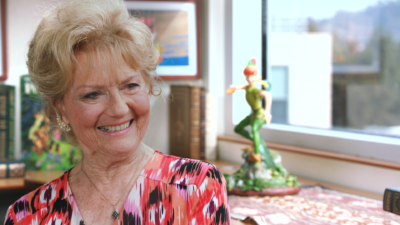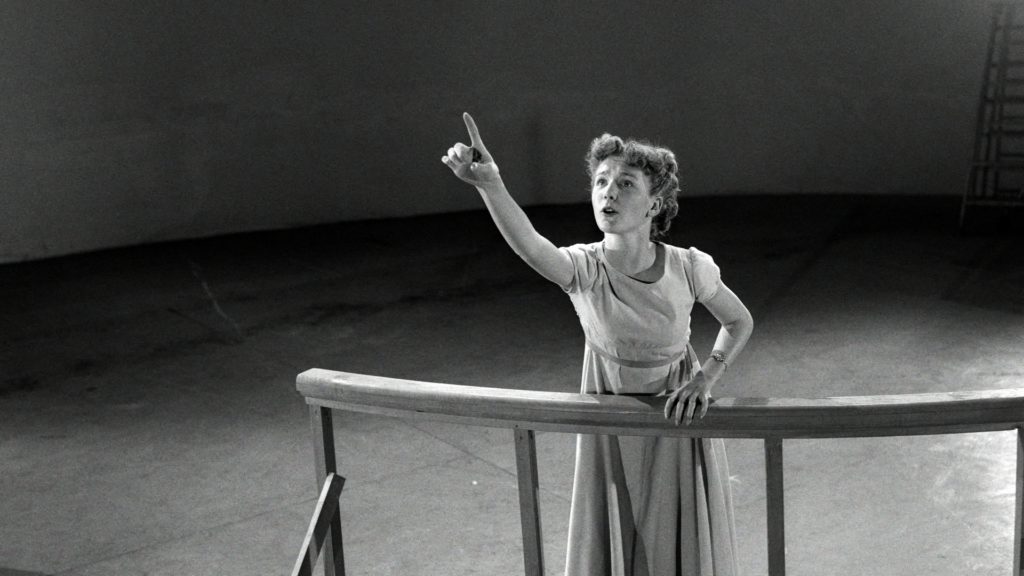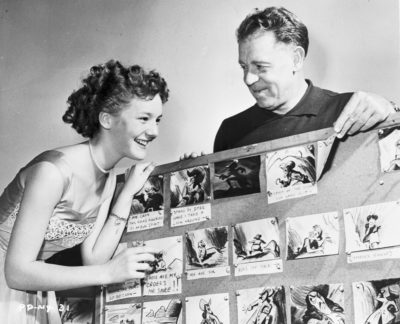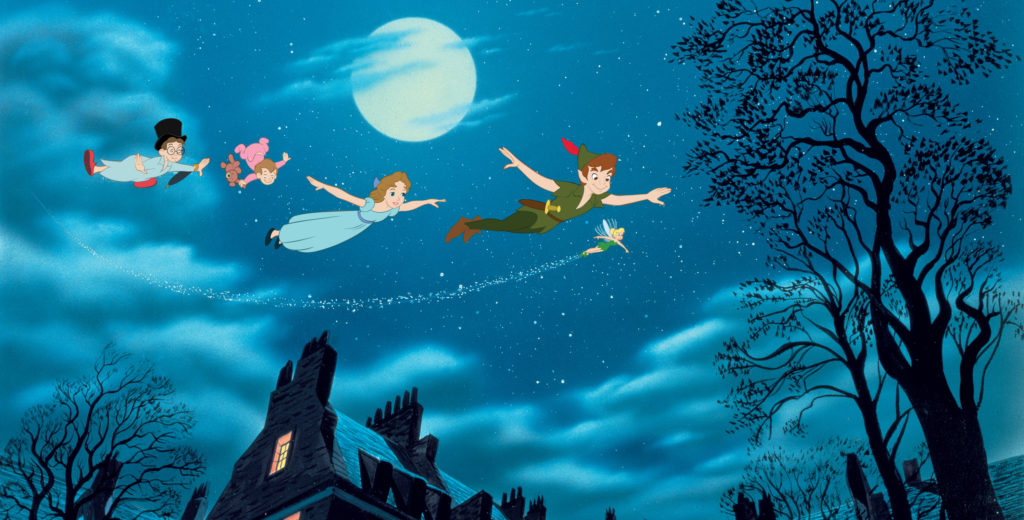 On May 15th, I had the great pleasure of speaking with two of the loveliest ladies to ever be involved with the Walt Disney Company, Kathryn Beaumont and Mindy Johnson. Beaumont is a Disney Legend, providing the voice of both Alice from Alice in Wonderland and Wendy in Peter Pan. Mindy Johnson is a notable Disney Historian and an authority figure on both Tinker Bell and the Ink & Paint Department. To celebrate the Walt Disney Signature Collection of Walt Disney’s Peter Pan, I was gifted 15 minutes of their time. Step behind the ink and paint to learn what it was like to help make this timeless animated classic.
On May 15th, I had the great pleasure of speaking with two of the loveliest ladies to ever be involved with the Walt Disney Company, Kathryn Beaumont and Mindy Johnson. Beaumont is a Disney Legend, providing the voice of both Alice from Alice in Wonderland and Wendy in Peter Pan. Mindy Johnson is a notable Disney Historian and an authority figure on both Tinker Bell and the Ink & Paint Department. To celebrate the Walt Disney Signature Collection of Walt Disney’s Peter Pan, I was gifted 15 minutes of their time. Step behind the ink and paint to learn what it was like to help make this timeless animated classic.
Alex: Hello.
Kathryn Beaumont: Hi there!
Mindy Johnson: Hello, Alex!
Alex: How are you?
Kathryn Beaumont: Oh, fine. How are you doing?
Alex: I’m great. Thank you very much for this opportunity. Peter Pan was my favorite, favorite movie as a kid.
Kathryn Beaumont: Aww, that’s lovely.
Alex: I got to see the new bonus feature that you and Paul Collins did. So I was curious if you could share a little information about what it was like reuniting with him, if you stayed in touch over the years?
Kathryn Beaumont: Over the years, yes. And I think he actually lives on the other end of the country, and had flown in for a few things at the time. So, we were able to reconnect, and it was just wonderful. I hadn’t seen him in years and years and years. And it was great just to connect again, after all that length of time.
Alex: And what a lot of people don’t realize about the way voice work was done on Peter Pan and Alice in Wonderland is that there was the voice component, but also the live action reference component. You and Paul did the live action reference for Wendy, and John and you also got to do it for Tinker Bell a little bit, you mentioned in that bonus feature. How long of a process was it for you on both Alice and Pan?
Kathryn Beaumont: Well, it was how it was done in those days. And for both of the roles that I played … yeah, they had to do the live action, because it was a reference for the artist so that they could draw the figures in a more realistic fashion, and more fluid. So they could watch the movements, and then just help them to draw. So, the process was doing the voice first. You know doing the recordings. And then a few weeks later there would be a session of live action; a bare stage, with hardly any fixtures, you had to imagine almost everything. And they would do that just so that the film would show the characters moving and doing various different things, so that the animation looked more realistic. So, that was sort of how it was done long ago.
Alex: Yeah. And I think what’s really interesting about that process, and sort of the difference … I know you have some experience doing voice work, sort of in the modern era of animation. But nowadays you always hear about actors being alone in the studio and not even meeting their co-stars until the premier. But you guys actually got to work together quite a bit. Both in the studio, and on the sound stage.
Kathryn Beaumont: Yeah. That is definitely something that has obviously changed over the years, which I hadn’t been aware of, because I hadn’t been part of the career as an adult, that I remembered so distinctly, that when I was working on two roles than the other characters were there with me. And of course you can discuss together, and it’s more dynamic. You can sort of feel more about the characters that you’re playing and discuss it, and it just works a whole lot better than just listening to earphone conversation, and this is the other person’s voice and now you react to that particular thing. It’s a little more static today than it was then. And there were so many actors that came and went where I worked with, that it was just a lovely feeling to be standing there and doing recordings with these people who were really there, rather than just listening to a voice on the microphone.
Alex: I mean it sounds like you guys got the chance to really kind of grow together and bond, and build your characters in a really unique way. And in the bonus features-
Kathryn Beaumont: That’s it, because you talked about it in between the takes. Yes.
Alex: Yeah, and in the bonus feature you mentioned that you also got some really unique experiences getting to tour the animation departments, which I think is every Disney Animation fan’s wildest dream come true. To be able to just step back into the era and actually walk those halls and see all this artwork being created. One of those items that you mentioned was touring Ink & Paint. And I know Mindy is on the call and she has a fantastic book about the Ink & Paint Department.
Kathryn Beaumont: Yes, she certainly does.
Alex: Do you have any specific memories about visiting … well, any of the departments. But that one in particular that really stayed with you?
Kathryn Beaumont: Well, it all has stayed with me, because my whole experience with Disney was so special, that those memories are strong, and they have lasted over all these decades and decades. I was invited over to Ink & Paint and I had a little tour and everything. And I remember there were other times when it was okay during my recess to go and see how things were going along with one of the films. I’m not sure if it was Alice or Peter Pan, but they would say, “Oh, we’ve got some drawings here. Would you like to come over on your recess and have a look?” And so, my teacher and I would take our recess time and walk over to Ink & Paint and go into the department, and there were all the ladies working hard, and actually it was my learning experience, because I was watching how they did the paint part of the cels that were being produced for the film. So, it was very educational, but it was also wonderful because these ladies were so talented. And just visiting with them during my recess break was a delight. So I had some nice, nice experiences there.
Mindy Johnson: And that really was the place where the final touches of everything were put together. You know all of the working with the steps leading up to it is where the final color and the final elements would be completed and ready to go before camera. And it’s there that Ginni Mack, who was the actual model for Tinker Bell, worked on Peter Pan. She got a call out of the blue to come pose for a pixie and indeed for several settings she met with the directors and Marc Davis, the lead animator on Tinker Bell, and posed for them. And she would often wear her hair in a little tied up bun, and little side bangs. And found out then … that several months later then, as the show was nearing completion, that she, of course, had been the model for Tinker Bell. It’s a very sweet story.
Kathryn Beaumont: Yeah, it sure is.
Mindy Johnson: Your paths would have crossed in more ways than one. And then Kathy did live action reference for Tinker Bell.
Kathryn Beaumont: A little bit, because they weren’t sure how they wanted to show Tinker Bell’s character. They didn’t want it to be too sexy, they didn’t want it to be too tomboy-ish. So they were trying different methods to see different people, to see what the situation might be. So anyway, that’s how they had me do a little scene, as well as several others. Gosh, I remember, Elaine Stanley was another one who they called to come in and do a scene. So that was sort of how it all evolved.
Alex: I know you were born in England and moved to California at a fairly young age. Had you had much experience with both stories, Alice in Wonderland and Peter Pan, prior to being invited to be part of them?
Kathryn Beaumont: I mean, brought up, those were the classics. So obviously I was very well familiar with them both, Peter Pan and Alice in Wonderland, because everybody read those stories or had them read to them before they were able to read on their own. I knew both stories very, very well. They were very popular in England when I was growing up.
Alex: And this is sort of an interesting time. Peter Pan is coming out again on Blu-ray and digital and DVD and it’s celebrating an anniversary.
Kathryn Beaumont: I know; it’s very exciting!
Alex: And when both Alice in Wonderland and Peter Pan came out, there were TV specials that are very fondly remembered. I know I have seen One Hour in Wonderland. And that was kind of a new concept of promoting film. Do you have strong memories about making those TV specials?
Kathryn Beaumont: Just that it was a lovely experience and that I think that at the time that they came out, it was close to Christmas or something? So it was obviously shot in the summer time, which at that age was wonderful for me, because I didn’t have any schooling; it was summer break. And so they were able to work with me a little bit longer. And there was this business with counting the minutes for teacher, because the teacher was always with me at that time, because that was the way things were. And so the teacher had to write down the number of minutes I was working, and the number of minutes I was doing my schoolwork. So that it came out exactly right for the three hours of school for the day, and the four hours of work for the day. But in the summer time, there was no school and so I didn’t have to worry about that part of it. And so it was more of a relaxed sort of an atmosphere, because I didn’t have those things to work with during that time. So those are the things I kind of remember.
Mindy Johnson: But they were very significant specials. The One Hour in Wonderland was the first of its kind. And now it has established a standard special programming for Christmas Day. And it established a sort of a standard platform for Disney. Not only to entertain and to gather family around on a special day, but a little bit of promotion about the film, but to introduce the characters. And so it’s a real significant part of television history, and groundbreaking on Walt Disney’s part.
Kathryn Beaumont: I didn’t realize … I hadn’t thought about that, but that’s absolutely true. That it was something that was brand new at that time.
Mindy Johnson: Yeah, you were a ground breaker and you didn’t know it.
Alex: And you’ve talked quite a bit, Kathryn, about your teacher on the Disney studio lot. I know that you went into education as a career, as an adult. Was there anything about working with the studio teacher that sort of made you want to pursue that as a profession?
Kathryn Beaumont: Do you mean teaching as a profession? Is that what you’re talking about?
Alex: Exactly.
Kathryn Beaumont: Yeah. Well, the thing was, I had finished with the two girls and I had reached a point where I had to decide: What do I want to do for the rest of my life? And I had figured I better finish my schooling. Then that gave me time to work out my feelings towards what did I want to do for the rest of my life. And so, I knew that education was something that was important to me. And I eventually went to that direction instead. So, I eventually finished up at USC. And I got my teaching credentials; the teacher training and all of that, with USC. And eventually became a teacher. And that was my career as an adult.
Alex: Thank you so much for your time. I am so excited to share all this wonderful information and history with our readers. And I’m looking forward to the new Walt Disney Signature Collection of Peter Pan.
Kathryn Beaumont: Well it was a pleasure talking to you.
Alex: Likewise.
Mindy Johnson: Thank you, Alex.
Alex: Thank you. Take care!
Mindy Johnson: Take care! Bye!
You can learn more about the making of Walt Disney’s Peter Pan on the Walt Disney Signature Collection edition, which features a brand new bonus feature with Kathryn Beaumont where she reunites with her Darling brother John, as well as a Walt Disney Archives tour of Walt Disney’s office with an emphasis on his personal airplanes. The memory of talking with Kathryn Beaumont and Mindy Johnson is my new happy thought.



